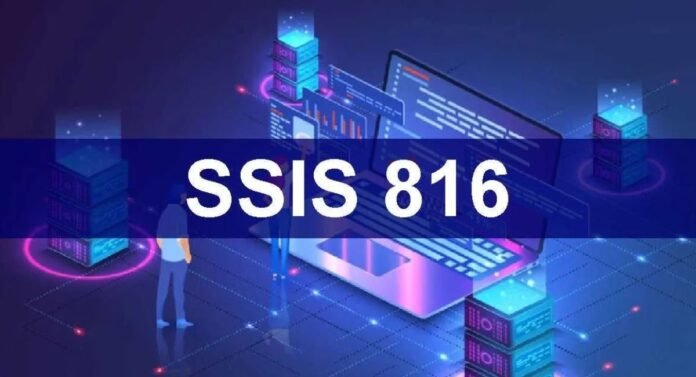Introduction
In the ever-evolving world of data management, SQL Server Integration Services (SSIS) plays a vital role. SSIS acts as a behind-the-scenes hero, meticulously transferring data between various sources and destinations. Within this realm, SSIS 816 emerges as a crucial component ensuring smooth and error-free data flow.
This article dives into the world of SSIS 816, explaining its purpose, functionalities, and its significance in the data integration process.
What is SSIS?
SQL Server Integration Services (SSIS) is a powerful tool within the Microsoft SQL Server suite. It specializes in extracting, transforming, and loading (ETL) data.
- Extracting: SSIS retrieves data from various sources, such as databases, flat files, or web services.
- Transforming: The extracted data can be modified, cleansed, or formatted to meet the requirements of the destination system.
- Loading: The transformed data is then delivered to its designated destination, such as another database, data warehouse, or reporting tool.
Understanding SSIS Packages
SSIS packages are essentially blueprints that define the entire data integration process. These packages contain instructions for each step, including the data source, transformations to be applied, and the final destination.
What is SSIS 816?
SSIS 816 refers to a specific error code encountered during the execution of an SSIS package. Whenever an error occurs during the data flow, SSIS assigns a unique error code to help identify the issue. Error code 816 specifically indicates a problem with the data transformation process within the package.
Common Causes of SSIS 816 Error
Several factors can contribute to the SSIS 816 error:
- Data Type Mismatch: If the data coming from the source doesn’t match the data type expected by the transformation, an error 816 might occur. For instance, attempting to convert a text string into a number when the source data contains non-numeric characters.
- Missing Data Conversion: Sometimes, SSIS might require explicit data conversion instructions within the transformation component. Forgetting to define these conversions can lead to error 816.
- Corrupted Data Source: If the source data itself is corrupt or contains invalid characters, it can cause issues during transformation and trigger error 816.
Resolving the SSIS 816 Error
Here’s how to troubleshoot and resolve the SSIS 816 error:
- Examine the Error Message: The error message accompanying code 816 often provides valuable clues about the specific issue. It might pinpoint the location within the package where the error occurred and offer hints on the potential cause.
- Review Data Mapping: Double-check the data mapping between the source and the transformation component. Ensure the data types align and any necessary conversions are defined.
- Inspect Data Source: If a corrupt data source is suspected, investigate the source data for inconsistencies or invalid characters. Cleaning or correcting the source data might be necessary.
- Utilize Debugging Tools: SSIS provides built-in debugging tools that allow you to step through the package execution and pinpoint where the error occurs. This can be helpful in identifying the exact transformation causing the issue.
Preventing SSIS 816 Errors
Here are some proactive measures to minimize the occurrence of SSIS 816 errors:
- Thorough Data Type Mapping: Define clear data type mappings between the source and the transformation to avoid mismatches.
- Implement Data Validation: Consider incorporating data validation steps within the package to identify any inconsistencies in the source data before the transformation stage.
- Regular Testing: Schedule regular testing of your SSIS packages to catch potential errors before they occur in a production environment.
Beyond SSIS 816: Common SSIS Error Codes
While SSIS 816 is a specific error code, it’s helpful to be familiar with some other frequently encountered SSIS error codes:
- DTS_E_CANNOTACCESSFILE (Error Code: -1072807203): This error indicates an issue with accessing the source or destination file.
- SSIS Error Code: 0: This seemingly harmless code can be misleading. It often signifies a more critical underlying issue within the package execution.
FAQs
What does SSIS stand for?
SSIS stands for SQL Server Integration Services.
What is the difference between SSIS and SSRS?
SSIS focuses on data integration (ETL), while SSRS (SQL Server Reporting Services) deals with report generation and data visualization.
Is SSIS a good skill to have?
Absolutely! SSIS is a valuable skill for data professionals as it helps automate data movement and transformation tasks, saving time and resources.
How do I learn more about SSIS?
Microsoft provides extensive documentation and tutorials on SSIS. Additionally, numerous online resources and communities offer valuable insights and support.
Conclusion
While SSIS 816 may seem like a hurdle, understanding its cause and rectification methods empowers you to maintain a smooth data flow. By implementing data validation, clear data mapping, and routine testing, you can minimize the occurrence of these errors. Remember, SSIS 816 is just one example; familiarizing yourself with common error codes equips you to troubleshoot various issues that might arise within your SSIS packages.
SSIS 816 signifies the importance of vigilance in data integration. It highlights the need for robust data validation and transformation processes to ensure the accuracy and consistency of your data. As you navigate the world of SSIS, remember that these challenges are opportunities to refine your packages and become an SSIS master.



